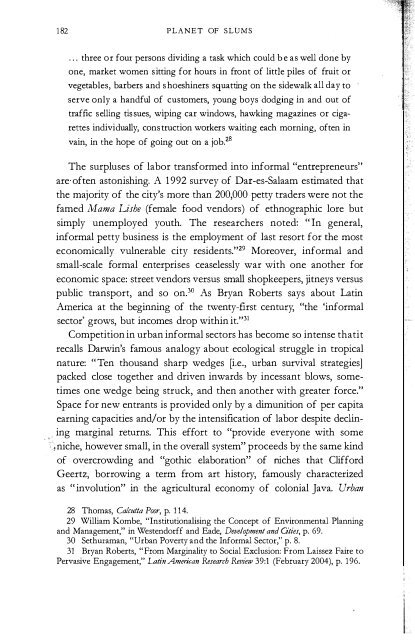Untitled - Rebel Studies Library
Untitled - Rebel Studies Library
Untitled - Rebel Studies Library
You also want an ePaper? Increase the reach of your titles
YUMPU automatically turns print PDFs into web optimized ePapers that Google loves.
182 PLANET OF SLUMS<br />
... three or four persons dividing a task which could be as well done by<br />
one, market women sitting for hours in front of little piles of fruit or<br />
vegetables, barbers and shoeshiners squatting on the sidewalk all day to<br />
serve only a handful of customers, young boys dodging in and out of<br />
traffic selling tis sues, wiping car windows, hawking magazines or ciga<br />
rettes individually, construction workers waiting each morning, often in<br />
vain, in the hope of going out on a job. 28<br />
The surpluses of labor transformed into informal "entrepreneurs"<br />
are often astonishing. A 1992 survey of Dar-es-Salaam estimated that<br />
the majority of the city's more than 200,000 petty traders were not the<br />
famed Mama Lishe (female food vendors) of ethnographic lore but<br />
simply unemployed youth. The researchers noted: "In general,<br />
informal petty business is the employment of last resort for the most<br />
economically vulnerable city residents."z9 Moreover, informal and<br />
small-scale formal enterprises ceaselessly war with one another for<br />
economic space: street vendors versus small shopkeepers, jitneys versus<br />
public transport, and so on.3D As Bryan Roberts says about Latin<br />
America at the beginning of the twenty-first century, "the 'informal<br />
sector' grows, but incomes drop within it."31<br />
Competition in urban informal sectors has become so intense thatit<br />
recalls Darwin's famous analogy about ecological struggle in tropical<br />
nature: "Ten thousand sharp wedges [i.e., urban survival strategies]<br />
packed close together and driven inwards by incessant blows, sometimes<br />
one wedge being struck, and then another with greater force."<br />
Space for new entrants is provided only by a dimunition of per capita<br />
earning capacities and/or by the intensification of labor despite declining<br />
marginal returns. This effort to "provide everyone with some<br />
,niche, however small, in the overall system" proceeds by the same kind<br />
of overcrowding and "gothic elaboration" of niches that Clifford<br />
Geertz, borrowing a term from art history, famously characterized<br />
as "involution" in the agricultural economy of colonial Java. Urban<br />
28 Thomas, Calcutta Poor, p. 114.<br />
29 William Kombe, "Institutionalising the Concept of Environmental Planning<br />
and Management," in Westendorff and Eade, Development and Gties, p. 69.<br />
30 Sethuraman, "Urban Poverty and the Informal Sector," p. 8.<br />
31 Bryan Roberts, "From Marginality to Social Exclusion: From Laissez Faire to<br />
Pervasive Engagement," Latin American Research Review 39:1 (February 2004), p. 196.<br />
A SURPLUS HUMANITY? 183<br />
involution, thus, seems an apt description of the evolution of informal<br />
employment structures in most Third World cities.32<br />
Tendencies toward urban involution, to be sure, existed during the<br />
nineteenth century. The European urban-industrial revolutions were<br />
incapable of absorbing the entire supply of displaced rural labor, especially<br />
after continental agriculture was exposed to the devastating<br />
competition of the North American prairies and Argentine pampas<br />
from the 1870s. But mass emigration to the settler societies of the<br />
Americas and Australasia, as well as Siberia, provided a dynamic safety<br />
valve that prevented the rise of mega-Dublins and super-Napleses, as<br />
well as the spread of the kind of under class anarchism that had taken<br />
root in the most immiserated parts of Southern Europe. Today, by<br />
contrast, surplus labor faces unprecedented barriers to emigration to<br />
rich countries.<br />
'J.- "''''-'_<br />
;: Sixth; )ecause they contend with such desperate conditions, it is<br />
pehaps"ot surprising that the poor turn with fanatic hope to a "third<br />
economy" of urban subsistence, including gambling, pyramid schemes,<br />
lotteries, and other quasi-magical forms of wealth appropriation. For<br />
example, in their study of the household economy of the Klong Thoey<br />
slum in the port of Bangkok, Hans-Dieter Evers and Rudiger Korff discovered<br />
that fully 20 percent of neighborhood income was redistributed<br />
through gambling and share games.33 Throughout the urban Third<br />
World, moreover, religious devotion revolves around attempts to influence<br />
fortune or importune good luck.<br />
Seventh, under such conditions, it is not surprising that initiatives<br />
such as micro-credit and cooperative lending, while helpful to those<br />
informal enterprises managing to .ead water, have had little macro<br />
impact on the reduction of poverty, even in Dhaka, the home of the<br />
world-famous Grameen Bank.34 Indeed, stubborn belief in "leveraging<br />
the micro-enterprise," writes Jaime Joseph, a veteran community<br />
32 Clifford Geertz, Agricultural Involution: The Processes of Ecological Change in<br />
Indonesia, Berkeley 1963, pp. 80-82. T. McGhee uses the "urban involution" metaphor<br />
in "Beachheads and Enclaves: The Urban Debate and the Urbanization Process in<br />
Southeast Asia since 1945," in Y M. Yeung and C. P. Lo (eds), Changing South-East<br />
Asian Cities: Readings on Urbanization, London 1976.<br />
33 Evers and Korff, Southeast AJian Urbanism, p. 143.<br />
34 Serajul Hoque, "Micro-credit and the Reduction of Poverty in Bangladesh,"<br />
Journal of Contemporary Asia 34:1 (2004), pp. 21, 27.


